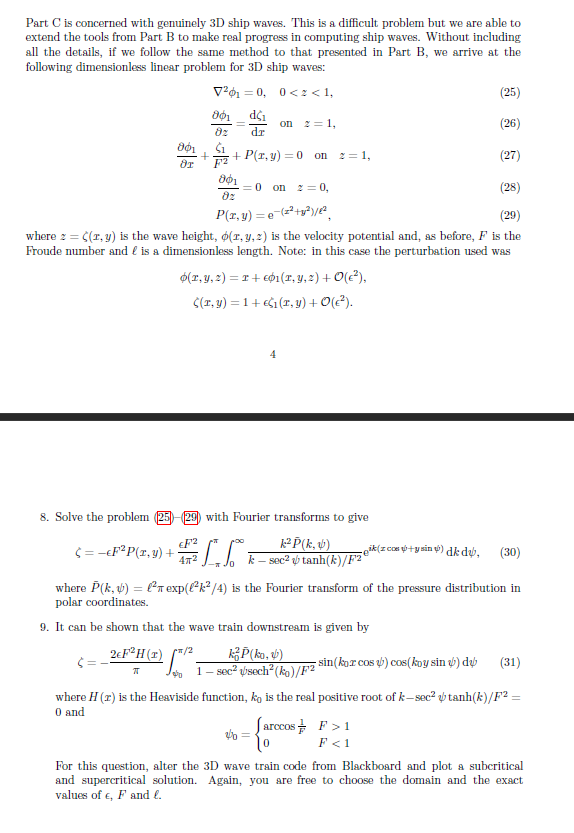Question
Please Note that they should be a 1 in front of equation 30 Matlab Code function zeta=linear3DSurfaceWaveTrainAlternate(x,y,epsilon,Fr) % linear3DSurfaceWaveTrainAlternate Computes the surface height of the
Please Note that they should be a 1 in front of equation 30

Matlab Code
function zeta=linear3DSurfaceWaveTrainAlternate(x,y,epsilon,Fr) % linear3DSurfaceWaveTrainAlternate Computes the surface height of the linear wave train % for flow past a Gaussian pressure distribution over a rectangular mesh. % X - x values of the mesh Note: X and Y are from the meshgrid function % Y - y values of the mesh % epsilon - strength of teh pressure % Fr - the Froude number
N = length(x(:));
zeta = zeros(size(x));
% Pressure P = @(x,y) exp(-(x.^2+y.^2));
% Fourier transform of the pressure Pf = @(k) pi*exp(-k.^2/4);
k0 = getk0(Fr);
% For all values on the mesh parfor i=1:N % Set up the integrand integrand = @(k) integrandFunc(k,x(i),y(i),Fr,Pf); % Compute integral zeta(i) = -epsilon*Fr^2*heaviside(x(i))/pi*real(integral(integrand,k0,inf));
end
end
function int = integrandFunc(k,x,y,Fr,Pf) % function evaluates the integrand the infinite depth equivalent of % equation from the email
psi0 = getPsi0(k,Fr); int = k./sqrt(Fr^2*k-1).*Pf(k).*sin(k.*x.*cos(psi0)).*cos(k.*y.*sin(psi0));
end
function psi0 = getPsi0(k,Fr) % This function returns a vector of psi0 given a vector of k and a scaler Fr % The contents of this function will need to be changed for finite depth
psi0 = acos(1./(Fr*sqrt(k)));
end
function k0=getk0(Fr) % This function returns k0 given Fr % The contents of this function will need to be changed for finite depth
k0 = 1/Fr^2;
end
Part C is concerned with genuinely 3D ship waves. This is a difficult problem but we are able to extend the tools from Part B to make real progress in computing ship waves. Without including all the details, if we follow the same method to that presented in Part B, we arrive at the following dimensionless linear problem for 3D ship waves: (25) 0 2 1 (26) 02 (27) (28) on 2 0, 02 P(r, y) (29) where 2 S(r,y) is the wave height, o(r,y, 2) is the velocity potential and, as before, F is the Froude number and is a dimensionless length. Note: in this case the perturbation used was 8. Solve the problem with Fourier transforms to give EF (30) where P(k, v) exp(ER2/4) is the Fourier transform of the pressure distribution in polar coordinates. 9. It can be shown that the wave train downstream is given by sin (korcos cos(koy sin du (31) 1 sec2 vsech (ko)/F where H (r) is the Heaviside function ko is the real positive root of -sec2 tanh (k)/F 0 and arccos F 1 F 1 For this question, alter the 3D wave train code from Blackboard and plot a subcritical and supercritical solution. Again, you are free to choose the domain and the exact values of E, F andStep by Step Solution
There are 3 Steps involved in it
Step: 1

Get Instant Access to Expert-Tailored Solutions
See step-by-step solutions with expert insights and AI powered tools for academic success
Step: 2

Step: 3

Ace Your Homework with AI
Get the answers you need in no time with our AI-driven, step-by-step assistance
Get Started


